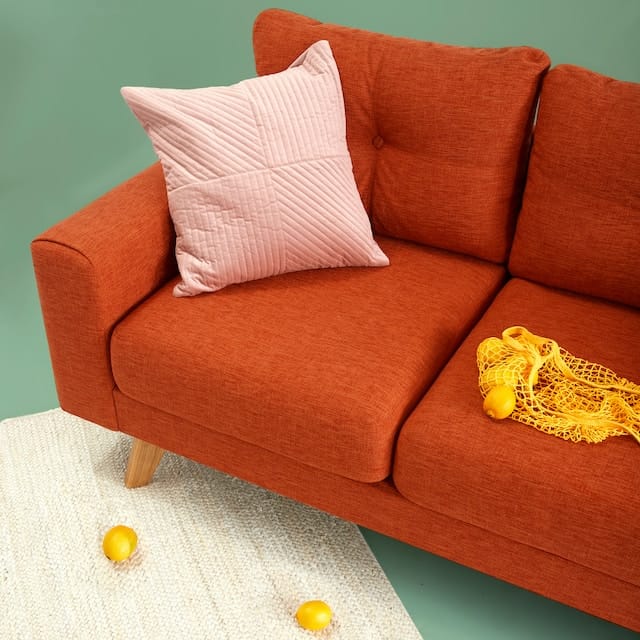
Getting blood stains out of a fabric couch can seem daunting, but with the right techniques and products, it is possible. Acting quickly when the stain first occurs gives you the best chance of removing it completely. However, even dried or set-in stains can often be lifted if you use a systematic approach.
This comprehensive guide covers everything you need to know to remove blood from fabric couches, including:
Follow these steps, and you can likely get your fabric couch looking clean and stain-free again.
When blood first spills onto a fabric couch, swift action is key. The sooner you can start working on the stain, the better chance you have of removing it completely.
If the stain is very fresh, the first step is to blot up as much excess blood as possible. Use a clean, dry white cloth or paper towels to gently press onto the stain and soak up the blood. Don’t scrub or rub the fabric, as this can further set the stain or spread it out.
Next, flush the stained area with cold water. The cold temperature helps congeal the blood, so less seeps into the fabric. Carefully dab the stain with a cloth soaked in cold water. Change clothes often so you are always blotting with a clean section.
Avoid warm or hot water, as higher temperatures can permanently set blood stains.
Be sure to check furniture tags first. “W” means the couch can be cleaned with water, while "S" means solvent cleaners only. If tags are missing or unclear, test water on a hidden area first.
Continue gently blotting, adding more cold water as needed, until the stain is removed. Change clothes frequently. If the stain persists, move on to applying a cleaning solution next. But often, diligent cold water blotting is enough to remove a fresh blood spill.
Before using any cleaner or home remedy on visible couch areas, first perform a test in an inconspicuous spot, like along the bottom edge or backside. Apply a dime-sized amount of the cleaning solution you want to try, let it sit according to package directions, then blot and rinse.
Check back after 24 hours; if no discoloration or damage has occurred where you spot tested, the method should be safe for the rest of the couch.
If cold water alone isn’t getting a fresh or set-in blood stain out, try applying one of these common household solutions next:
Hydrogen peroxide is often effective at lifting blood. Mix together:
Dip a clean white cloth into the solution and gently blot the stain. Allow it to fizz for a minute (this means it is working), then blot again. Rinse with cold water when done.
Mix a mild dish soap with cold water, then use a soft brush and cloth to gently scrub and blot the stain. The soap helps lift blood proteins from the fabric. Rinse thoroughly after.
Look for an enzyme-based pet stain cleaner or odour eliminator near the laundry detergents in grocery stores. These break down organic matter, like blood. Follow the package directions to pre-treat the stain.
Pour table salt liberally over the stain and let it sit for a few minutes to absorb the blood. Then, blot up the salt and dab the area with cold water. The salt helps draw blood out of the fabric.
Make a paste with baking soda and just enough cold water to moisten. Gently spread the paste over the stain using an old toothbrush or your fingers. Let it sit for 5–10 minutes, then wipe it away. Baking soda is an effective absorbent for lifting many fabric stains.
Soak the stain with club soda, which often helps lift blood and other protein-based stains. Blot repeatedly with clean sections of an absorbent cloth.
If a blood stain has already dried before you attempt to remove it, getting it out becomes more difficult. But don’t give up hope yet! With some chemical help and elbow grease, even old, set-in blood stains can sometimes release their grip on fabric.
The first step is loosening up that stubborn dried stain. Make a paste from powdered laundry detergent and cold water, then use an old toothbrush to gently scrub it into the fabric. You want to break down the hardened proteins in the blood without damaging the couch material itself.
Let the paste sit for 10–15 minutes to penetrate, then blot it away.
Flush the area with cold water, blotting repeatedly with clean white cloths to remove detergent residue and blood proteins that had loosened up.
If the stain persists, make a new paste, this time using meat tenderiser mixed with cold water. Meat tenderiser contains enzymes that further break down blood proteins. Scrub it in, let it sit for 15 minutes, then blot and rinse.
If needed, apply some chemical power next. Mix equal parts hydrogen peroxide and household ammonia in a spray bottle. Spritz liberally over the stain, let bubble for a minute, then blot continuously with clean cloths. The combination of peroxide and ammonia can help lift out the most stubborn dried-in stains.
Rinse the area thoroughly when done to remove all chemical residue.
Note: Never mix ammonia and bleach products; doing so creates toxic fumes.
If you’ve tried every home remedy with no success, the blood stain may require professional cleaning at this point. Upholstery and carpet cleaning companies have access to more powerful chemical cleaning agents that can penetrate deep into fabric to lift out dried or set-in stains.
The longer a blood stain sits untreated, the harder it is to remove, as it bonds on a molecular level to fabric fibres. Don’t throw out the couch just yet; call in the experts and see if they can get it looking fresh again.
However, some fabric couch materials don’t respond well to any stain removal methods, like suede, velvet, microfibers, and delicate antique fabrics. If you spot a test and see colour changes or damage, stop cleaning attempts and call a pro immediately. Aggressive scrubbing or chemicals could ruin the couch completely.
Once you get your couch stain-free again, follow these tips to help prevent new blood stains in the future:
Although blood can be one of the toughest stains to remove from fabric furniture, it is possible if you use the right techniques. The key is to act fast on fresh stains while carefully testing products and procedures first. For dried or set-in stains, be patient and persistent; working stains loosen little by little. And if you’ve given it your best shot to no avail, call in the pros to tackle the really tricky stains.

Harry Virk is the director of CleaningPro Auckland. He has years of experience in the cleaning industry and his company is expert at providing exceptional cleaning services in Auckland. He has a passion for helping people and making sure that their homes are clean, tidy, and ready for visitors.




